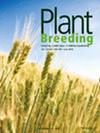Decoding the genetic basis of ear‐related traits in maize (Zea mays L.) using linkage mapping, association mapping and genomic prediction
IF 1.8
4区 农林科学
Q2 AGRONOMY
引用次数: 0
Abstract
As important yield components, the genetic analysis of ear‐related traits could provide a theoretical basis for maize breeding. Here, we reported the comprehensive genetic architecture of five ear‐related traits using 150 recombinant inbred lines (RIL) populations derived from the cross between Xu178 and K12. Besides, two sets of association populations were used to dissect genetic loci of five traits by genome‐wide association study (GWAS). A total of 32 QTLs of ear‐related traits were detected in the linkage mapping. Based on the mixed linear model (MLM), a total of 117 significant SNP markers of ear‐related traits were detected. Furthermore, a combined GWAS and linkage mapping analysis revealed 51 significant SNP markers fell within the confidence interval of QTLs. A total of seven co‐located significant SNP markers among different traits were found. Finally, six important candidate genes related to grain development were screened out. In addition, through haplotype analysis, two favourable haplotypes were found on chromosome 4, which could increase row number per ear (RNE), kernel number per row (KNR) and grain yield per plant (GYP) to a certain extent. Compared with the random model, the prediction accuracy of genomic prediction (GP) was improved in different degrees by considering the significant SNP markers as fixed effects. The stable genetic QTLs, candidate genes and favourable haplotypes found in this study are valuable resources, which will provide theoretical reference for high‐yield breeding of maize. Taken together, the research results also highlight the benefits of integrating GWAS with GP to further improve the accuracy of GP.利用连接图谱、关联图谱和基因组预测解码玉米(Zea mays L. )穗相关性状的遗传基础
穗相关性状是玉米产量的重要组成部分,对其进行遗传分析可为玉米育种提供理论依据。在此,我们利用许178和K12杂交得到的150个重组近交系(RIL)群体,研究了5个穗相关性状的综合遗传结构。此外,我们还利用两组关联群体,通过全基因组关联研究(GWAS)剖析了五个性状的遗传位点。在连接图谱中,共检测到 32 个穗相关性状的 QTLs。基于混合线性模型(MLM),共检测到 117 个与耳相关性状的显著 SNP 标记。此外,结合 GWAS 和连接图谱分析发现,有 51 个显著的 SNP 标记位于 QTLs 的置信区间内。在不同性状之间共发现了 7 个共定位的重要 SNP 标记。最后,筛选出 6 个与谷粒发育相关的重要候选基因。此外,通过单倍型分析,在 4 号染色体上发现了两个有利的单倍型,它们能在一定程度上增加每穗行数(RNE)、每行粒数(KNR)和每株谷粒产量(GYP)。与随机模型相比,将显著的 SNP 标记作为固定效应的基因组预测模型(GP)的预测精度有不同程度的提高。本研究发现的稳定遗传 QTLs、候选基因和有利单倍型是宝贵的资源,将为玉米高产育种提供理论参考。综上所述,该研究成果也凸显了将 GWAS 与 GP 相结合进一步提高 GP 精确度的益处。
本文章由计算机程序翻译,如有差异,请以英文原文为准。
求助全文
约1分钟内获得全文
求助全文
来源期刊

Plant Breeding
农林科学-农艺学
CiteScore
4.40
自引率
5.00%
发文量
74
审稿时长
3.0 months
期刊介绍:
PLANT BREEDING publishes full-length original manuscripts and review articles on all aspects of plant improvement, breeding methodologies, and genetics to include qualitative and quantitative inheritance and genomics of major crop species. PLANT BREEDING provides readers with cutting-edge information on use of molecular techniques and genomics as they relate to improving gain from selection. Since its subject matter embraces all aspects of crop improvement, its content is sought after by both industry and academia. Fields of interest: Genetics of cultivated plants as well as research in practical plant breeding.
 求助内容:
求助内容: 应助结果提醒方式:
应助结果提醒方式:


